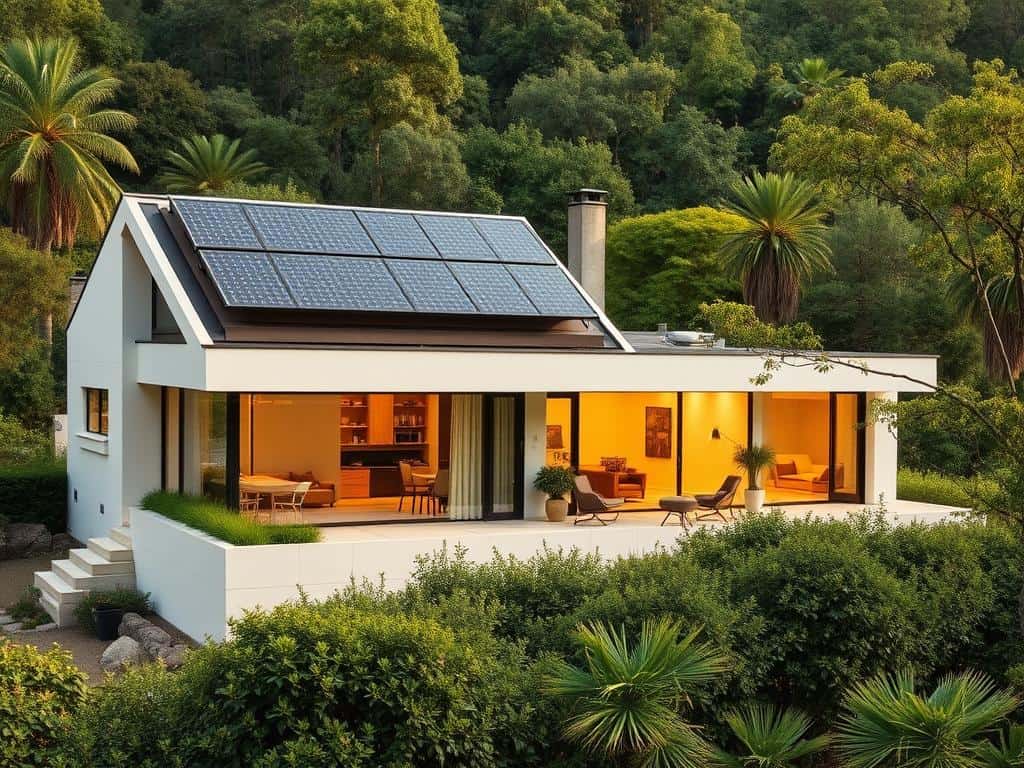
Homes cause about 20% of the United States’ greenhouse gas emissions. The creation of Eco Smart Homes is a response to environmental issues. These homes use new tech and green methods to cut down on pollution and increase comfort.
Adopting sustainable technologies and energy-efficient devices turns a regular home into a green smart home. This kind of home saves resources and creates a healthier place to live. Thanks to the Internet of Things (IoT), controlling how much energy we use is easy. This makes it a great time to start building an eco-friendly smart home.
Key Takeaways
- Eco Smart Homes significantly reduce greenhouse gas emissions.
- Integrating sustainable tech ensures energy efficiency.
- Eco-friendly practices promote healthier living environments.
- Smart devices offer real-time energy management.
- Building green smart homes can increase property value.
Understanding Eco Smart Homes
The world today really needs us to think about sustainability. Talking about Eco Smart Homes, I see they’re key for a greener future. They mix sustainable tech with green habits. This mix is a big step in cutting down our carbon footprint.
The Importance of Sustainability
Houses cause almost 40% of the world’s CO2 emissions, so we need to act. Using green habits helps fight this and saves energy. By picking energy-saving tech, homeowners like me can use less energy. This also makes our planet healthier.
Benefits of Eco Smart Homes
Eco Smart Homes bring many good things. They help save money on energy bills and make homes more efficient. With smart systems, I can easily control lights and temperature. This can cut energy use by about 15% and lower carbon emissions too.
Living in an Eco Smart Home also means enjoying its smart benefits. It makes life greener and increases my house’s value over time.
Key Features of Eco Smart Homes
On my eco-friendly smart home journey, I found key features that improve sustainability and efficiency. These advancements support a greener lifestyle and cut utility costs. Here are the essential features I discovered:
Smart Lighting Solutions
Smart lighting has changed how I light up my home. By using energy-saving LED bulbs, I’ve cut my energy use by 75% over old-school bulbs. Systems like Lutron Caséta let me set the mood while saving up to 40% on energy.
With motion sensors and schedules, my lights only turn on when needed. This smart setup makes life easier and boosts my energy-saving efforts.
Climate Control Technology
Adding smart climate control has been amazing for keeping my house comfortable. Smart thermostats, like Google Nest, let me control the temperature precisely. It saves energy and money, cutting about 12% off heating and 15% off cooling bills.
This tech ensures I use energy wisely based on my schedule. So, I stay comfy without wasting resources.
Water Conservation Devices
Smart water devices have revolutionized how I save water. Things like smart irrigation systems water my lawn efficiently. And IoT leak detectors, from brands like Phyn, monitor water use and alert me to leaks.
Thanks to these tools, I greatly reduce water waste. On average, I’m saving around 180 gallons of water a week in my home.

Conclusion
Exploring the eco-smart home journey shows a major shift towards sustainable living. Choosing energy-efficient options and smart tech brings both cost savings and a healthier lifestyle. It’s a big step for our earth’s future.
Every choice in making an eco-smart home reduces my environmental impact and boosts my home’s value. Eco-smart homes blend modern living with care for the planet. This makes sustainability a realistic aim for all homeowners.
The push for green innovations is growing strong. This shows moving to sustainable living is necessary, not just a passing phase. Creating an eco-smart home now means comfort today and a promise of a brighter future for all.